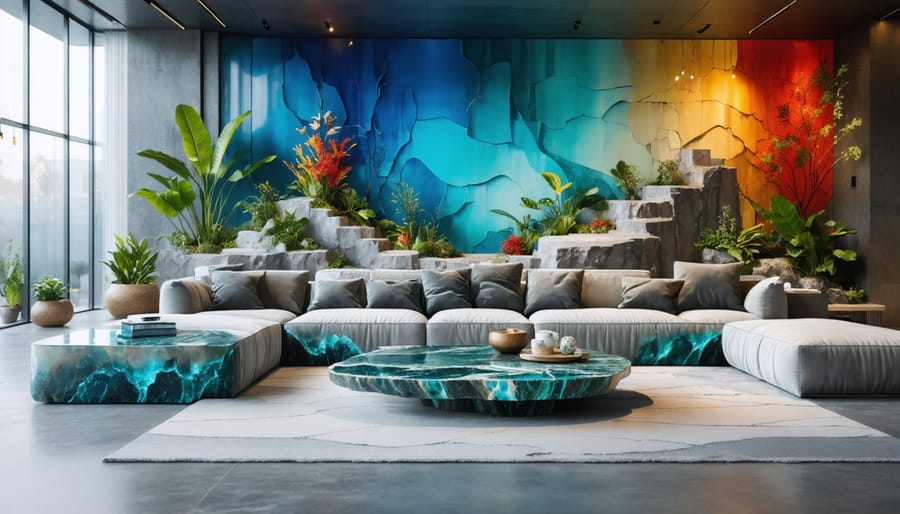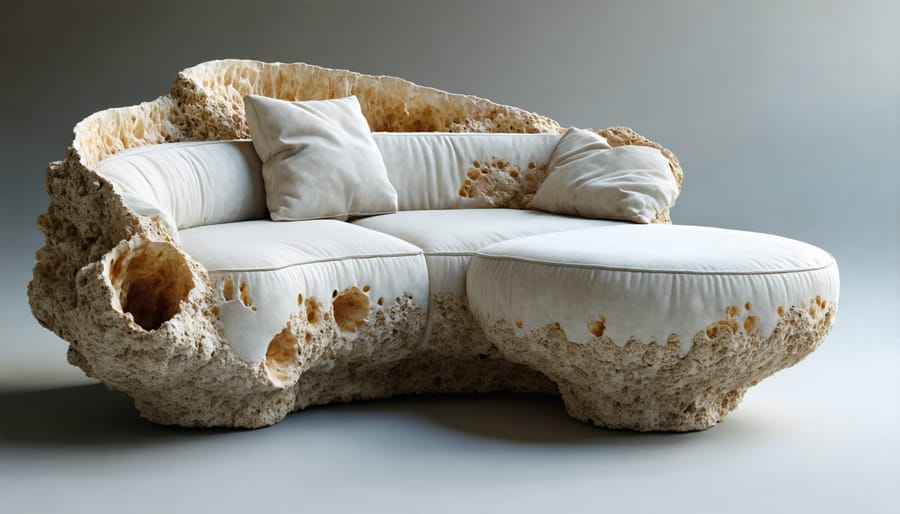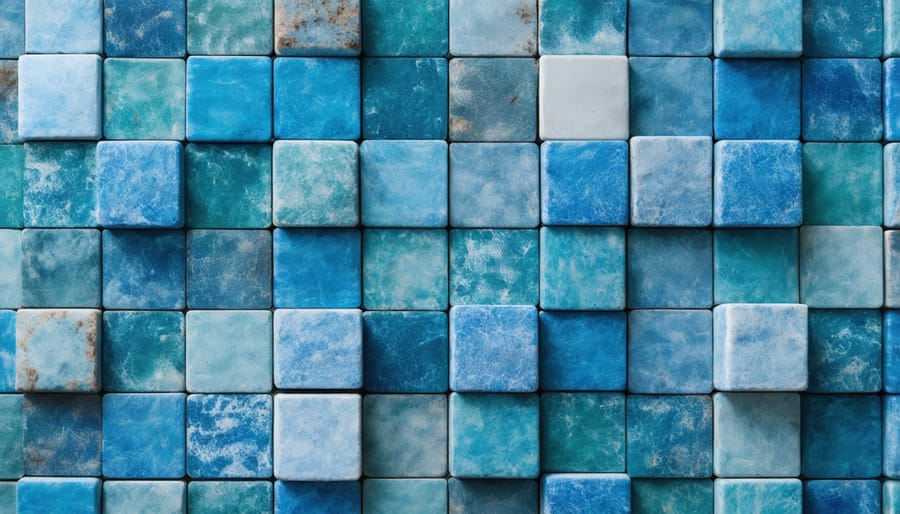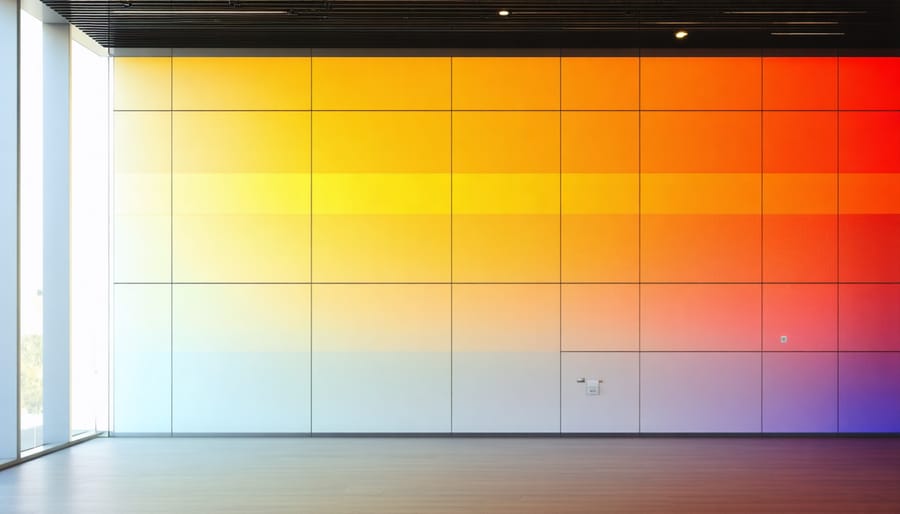
Smart, Sustainable Materials That Transform Interior Design
Transform your living spaces with groundbreaking materials that blend sustainability, aesthetics, and cutting-edge technology. Today’s innovative interior materials aren’t just beautiful – they’re revolutionizing how we think about home design, from self-cleaning surfaces to air-purifying walls.
Modern interiors now feature remarkable advances like thermochromic tiles that change color with temperature, mushroom-based building blocks that rival traditional materials in strength, and transparent wood composites that offer natural insulation while letting in abundant light. These next-generation materials aren’t just transforming the look of our spaces; they’re actively contributing to healthier, more sustainable living environments.
Whether you’re planning a complete renovation or seeking smart upgrades for your space, the latest material innovations offer solutions that were unimaginable just a few years ago. From recycled glass countertops that sparkle like precious stones to biodegradable acoustic panels that absorb sound while improving air quality, these materials prove that cutting-edge design and environmental responsibility can work in perfect harmony.
Each of these innovations represents a step toward smarter, more sustainable interiors that don’t compromise on style or functionality. As we embrace these new materials, we’re not just designing spaces – we’re creating the future of interior living.
Bio-Based Materials Revolutionizing Interior Design
Mycelium-Based Materials
Nature’s most innovative building material might be growing right beneath our feet. Mycelium, the root structure of mushrooms, is revolutionizing how we think about eco-friendly furniture materials and wall coverings. This remarkable fungal network can be grown and shaped into virtually any form, creating sturdy, lightweight, and completely biodegradable materials.
What makes mycelium-based materials truly exceptional is their minimal environmental impact. The growing process requires little energy, and manufacturers can use agricultural waste products as the growth medium. When molded and dried, mycelium creates panels and furniture components that are naturally fire-resistant, water-resistant, and provide excellent acoustic properties.
DIY enthusiasts can even experiment with growing their own mycelium materials at home. The process involves mixing mycelium spores with organic matter like sawdust or agricultural waste, placing the mixture in molds, and allowing it to grow for several days. Once fully grown, the material is dried to stop the growth process, resulting in a durable, sustainable product.
Companies are now offering mycelium-based wall panels, furniture components, and decorative elements that rival traditional materials in both aesthetics and performance. These products come in various textures and can be finished with natural dyes or left in their natural state for an organic look. The best part? At the end of their lifecycle, these materials can be completely composted, returning nutrients to the soil.

Recycled Agricultural Waste Products
Agricultural waste is finding new life in interior design through innovative processing techniques that transform crop residues into stunning and sustainable materials. These eco-friendly alternatives are revolutionizing how we think about interior finishes while helping reduce agricultural waste.
One of the most versatile options is wheat straw board, which combines compressed wheat stalks with eco-friendly resins to create sturdy panels perfect for cabinetry and furniture. These boards offer a unique texture and warm, natural coloring that adds character to any space while maintaining durability comparable to traditional particleboard.
Rice hulls, typically discarded after processing, are now being transformed into decorative wall panels and tiles. When combined with natural binders, these materials create beautiful, textured surfaces that provide excellent acoustic properties and add a distinctive organic feel to interior spaces.
Corn husks and stalks are finding new purpose in composite materials that can be molded into decorative panels, trim, and even furniture components. These materials offer a fascinating blend of sustainability and style, with natural variations that create unique patterns in each piece.
For flooring applications, compressed bamboo and agricultural waste composites provide excellent alternatives to hardwood. These materials are incredibly durable and offer superior moisture resistance, making them ideal for high-traffic areas and spaces prone to humidity.
The best part? These materials often cost less than traditional options while offering superior environmental benefits and unique aesthetic qualities that can’t be replicated with conventional materials.
Advanced Recycled Materials
Ocean Plastic Innovations
In recent years, innovative manufacturers have transformed ocean-bound plastic waste into stunning interior materials, offering both environmental benefits and unique aesthetic appeal. These materials range from decorative wall panels that shimmer like ocean waves to durable countertops that tell a story of sustainability.
One standout innovation is recycled ocean plastic tiles, which combine recovered fishing nets and plastic bottles to create vibrant, mosaic-like surfaces perfect for bathroom walls or kitchen backsplashes. These tiles not only prevent plastic from harming marine life but also bring a distinct coastal feel to interior spaces.
Furniture makers are also embracing ocean plastic, incorporating it into everything from chair frames to table surfaces. These pieces often feature speckled or marbled patterns that naturally occur during the recycling process, making each item unique. Some manufacturers even maintain transparency about the source of their materials, allowing customers to trace the journey from ocean to living room.
For commercial spaces, acoustic panels made from compressed ocean plastic are gaining popularity. These panels reduce noise while showcasing an eco-conscious commitment, featuring subtle blue and green hues that remind users of their oceanic origin.
The durability of these materials often matches or exceeds traditional options, with many products carrying warranties of 10 years or more. This longevity, combined with their environmental impact, makes ocean plastic materials an increasingly attractive choice for sustainable interior design.

Upcycled Construction Waste
The growing trend of using repurposed building materials in interior design isn’t just environmentally conscious – it’s revolutionizing how we think about beautiful spaces. Construction waste like concrete chunks, old bricks, and reclaimed wood are finding new life in stunning interior features. These materials bring character and history to spaces while reducing landfill waste.
Broken concrete pieces, once destined for disposal, are now being transformed into sleek countertops and dramatic accent walls. When sealed properly, they offer a modern industrial aesthetic that rivals expensive manufactured materials. Salvaged wood from demolition sites is particularly versatile, working beautifully as floating shelves, accent walls, or custom furniture pieces.
Old bricks and tiles are getting creative makeovers too. Cleaned and refinished, they create eye-catching feature walls or unique flooring patterns. Even metal scraps from construction sites are being repurposed into stylish light fixtures and decorative elements.
The best part? These materials often cost significantly less than new alternatives. Many suppliers now specialize in construction waste recovery, making it easier than ever to source quality materials. When working with upcycled materials, remember to properly clean and treat them for indoor use, and always verify they’re free from harmful substances like lead paint or asbestos.
Smart Sustainable Materials
Self-Cleaning Surfaces
Imagine never having to scrub your walls or countertops again. Thanks to breakthrough nanotechnology, self-cleaning surfaces are revolutionizing how we maintain our interior spaces. These innovative materials use microscopic structures inspired by nature, like the lotus leaf, to repel water, dirt, and even bacteria.
The secret lies in the surface’s nano-engineering, which creates an ultra-fine texture that prevents particles from sticking. When water hits these surfaces, it forms perfect beads that roll off, taking dirt and grime with them. This hydrophobic effect isn’t just clever science – it’s a practical solution for busy homeowners and property managers looking to reduce maintenance time and cleaning costs.
Most self-cleaning surfaces incorporate titanium dioxide, which activates under UV light to break down organic matter. This photocatalytic process means that stains, odors, and harmful bacteria are naturally eliminated without harsh chemicals. Some advanced coatings even work in low-light conditions, making them perfect for interior applications.
These materials are available in various forms, from paint and wall coverings to countertop finishes and window treatments. While the initial investment might be higher than traditional materials, the long-term benefits include reduced cleaning time, lower maintenance costs, and improved indoor air quality. For high-traffic areas like kitchens and bathrooms, self-cleaning surfaces are particularly valuable, offering both practical functionality and peace of mind.
Temperature-Responsive Materials
Temperature-responsive materials are revolutionizing how our living spaces interact with environmental changes. These smart materials automatically adjust their properties based on temperature fluctuations, creating more comfortable and energy-efficient interiors.
One of the most exciting innovations is thermochromic paint, which changes color as temperatures rise or fall. Imagine walls that shift from cool blues in summer to warm amber tones in winter, naturally complementing the season. These paints aren’t just decorative – they can help regulate room temperature by absorbing or reflecting heat as needed.
Phase-change materials (PCMs) are another game-changing solution. Embedded in walls or furniture, these materials absorb excess heat during the day and release it when temperatures drop, acting as a natural temperature buffer. Some manufacturers now offer PCM-enhanced drywall and textile products that can reduce heating and cooling costs by up to 30%.
Smart textiles with temperature-adaptive properties are making their way into upholstery and window treatments. These fabrics can expand or contract their fibers to trap or release heat, maintaining optimal comfort levels. For example, some curtains become more insulating in cold weather and more breathable in warm conditions.
For DIY enthusiasts, thermochromic films are an accessible starting point. These easy-to-apply window films automatically tint when exposed to direct sunlight, reducing heat gain and glare without compromising natural light.

Practical Implementation Tips
When incorporating innovative materials into your space, start with a clear plan and take inspiration from these sustainable interior design examples. Begin with smaller projects, like accent walls or furniture pieces, to get comfortable working with new materials before tackling larger installations.
For recycled glass countertops, ensure your cabinets can support the weight, and always work with certified installers who have experience with these specific materials. When using cork flooring, allow the material to acclimate to your home’s environment for at least 72 hours before installation to prevent warping or gaps.
Smart glass installations require professional electrical work, so factor this into your budget and timeline. For best results, integrate smart glass controls with your home automation system during the initial installation rather than retrofitting later.
When working with living walls, install proper drainage and irrigation systems first. Choose plants based on available light and maintain consistent care schedules. Consider starting with a small vertical garden before committing to a full wall installation.
For bamboo applications, remember that this material can be sensitive to humidity changes. Use appropriate sealants and maintain consistent indoor humidity levels between 40-60% for optimal performance. When installing bamboo flooring, leave an expansion gap around the perimeter to accommodate natural movement.
With mycelium-based materials, ensure proper sealing to prevent moisture absorption. These materials work best in dry areas with good ventilation. Start with decorative panels or small furniture pieces to test their durability in your space.
For photochromic surfaces, consider the natural light patterns in your room throughout the day. Position these materials where they’ll create the most impact without being overwhelming. Install light sensors strategically to maximize the effectiveness of color-changing properties.
Remember to:
– Always check local building codes before installing new materials
– Request samples to test in your space before full installation
– Work with suppliers who provide detailed installation guidelines
– Keep maintenance instructions for future reference
– Document the installation process for warranty purposes
– Consider professional installation for complex materials
These steps will help ensure successful integration of innovative materials while maintaining their longevity and performance.
The integration of innovative materials in interior design has revolutionized how we approach sustainable living spaces. These groundbreaking solutions not only reduce our environmental footprint but also create healthier, more efficient environments for occupants. From recycled glass countertops to mushroom-based insulation, these materials prove that eco-conscious design doesn’t mean compromising on style or functionality.
The impact extends beyond individual spaces, influencing the entire construction and design industry. Manufacturers are increasingly investing in research and development of sustainable alternatives, driving down costs and making these materials more accessible to homeowners and designers alike. This shift has created a ripple effect, encouraging more sustainable practices throughout the supply chain and inspiring new generations of designers to prioritize environmental responsibility.
Looking ahead, the future of interior design appears increasingly sustainable, with innovative materials leading the way. As technology advances and consumer awareness grows, we can expect even more exciting developments in eco-friendly materials. The movement toward sustainable interiors isn’t just a trend – it’s becoming the new standard in design, offering solutions that benefit both our living spaces and the planet.
By embracing these innovative materials, we’re not just designing beautiful interiors; we’re investing in a more sustainable future for generations to come. The transformation of our living spaces through these materials demonstrates that sustainability and style can go hand in hand, creating environments that are both beautiful and responsible.
